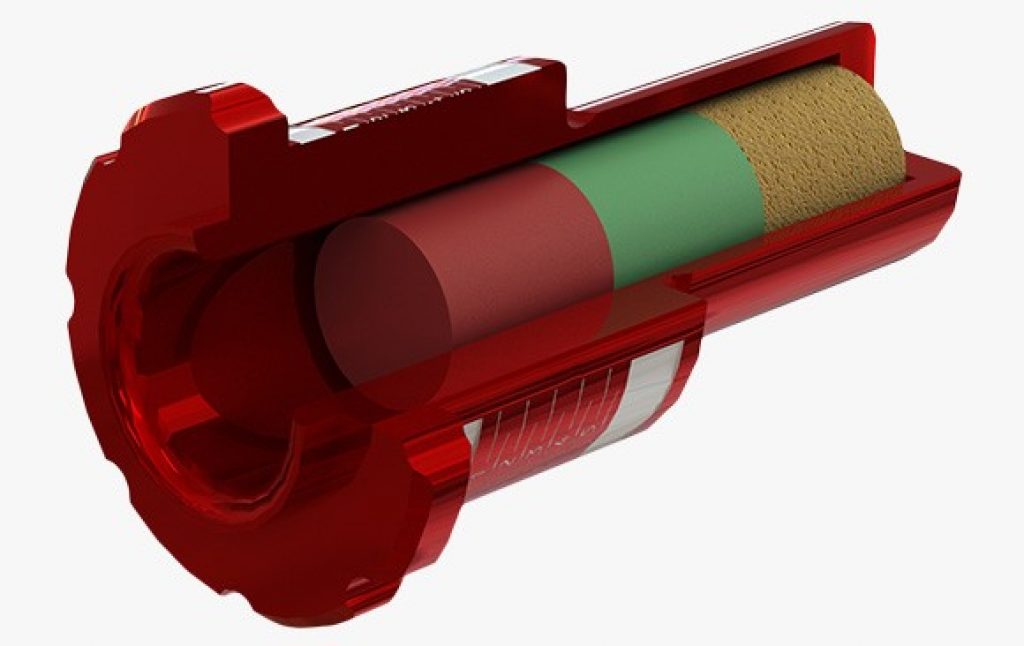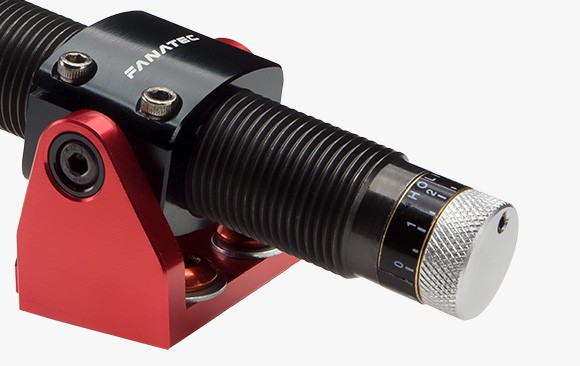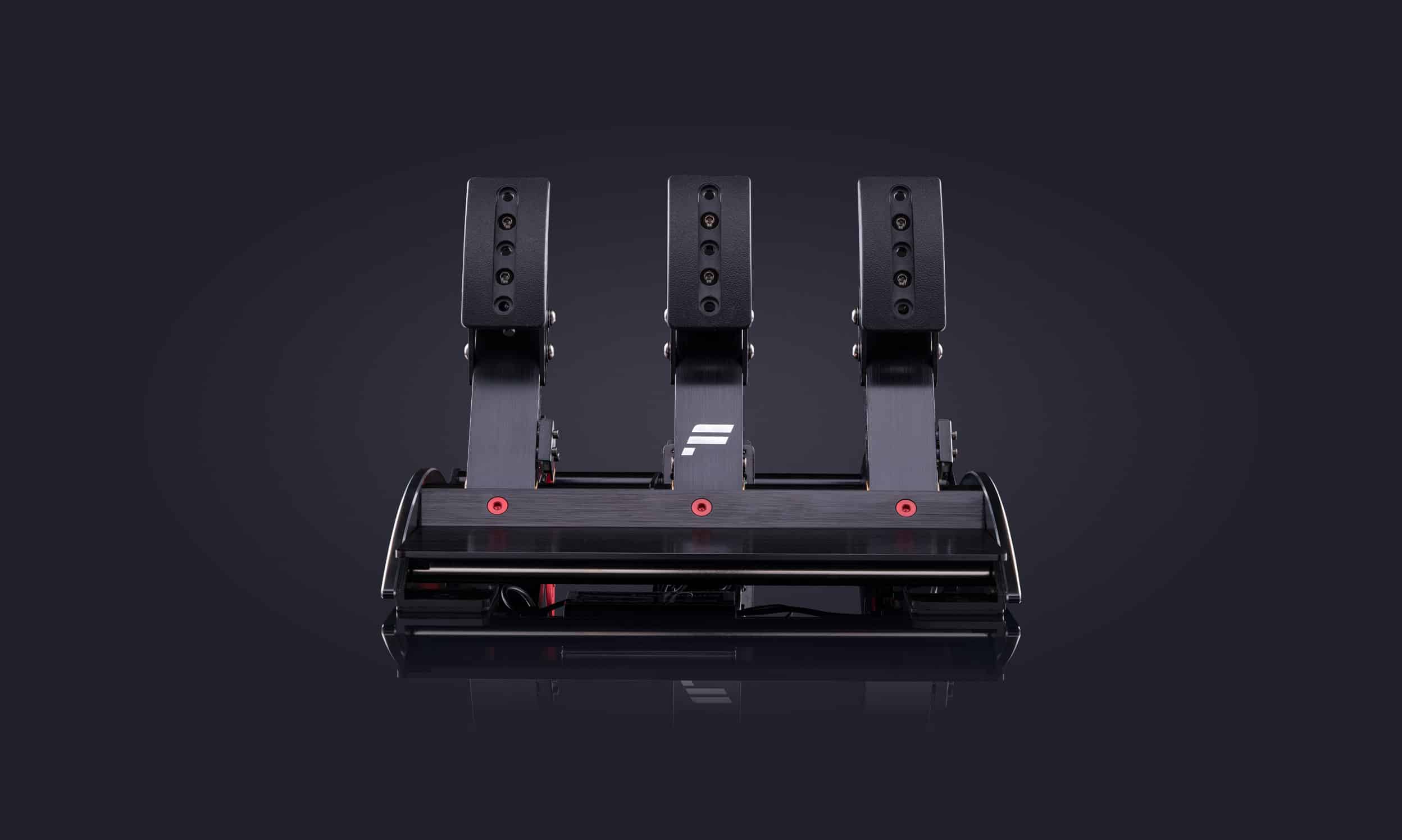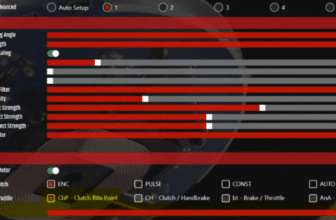Which Fanatec pedalset to choose? It’s a question we’re regularly asked, and one that’s a little more complex than you might think. Today’s range of simracing pedalsets is highly diversified. There’s something for every taste and every price.
Despite this, the German brand’s models still have a few advantages over their direct competitors. So let’s take a look at the three current models, and see which one is right for you 🙂
Fanatec pedalset in brief
There are three main models: the CSL Pedals, the new CSL Elite Pedals V2 and the legendary Clubsport V3. With the exception of the CSL Elite, all offer options that radically alter the gaming experience.
You’ll quickly notice that all Fanatec models are built in metal or aluminum. There’s no plastic finish like that of our main console competitor, the Thrustmaster T-LCM, for example. Here, we’re dealing with sturdiness and modularity. To begin with, I’d like to give you an overview of the three models and their main advantages and disadvantages.
You will be able to upgrade your pedalboard little by little to end up with a 3 pedals and a Load Cell sensor brake.
A great way to get started without breaking the bank!
Very scalable
Completely made of metal
Standard magnetic sensors and optional Load Cell brake
Very, very basic design…
It’s a pedal board that has proven itself over many years. In this price range, it is still the dominant model today.
Possibility of upgrading it with options (Damper kit and Brake performance kit)
The brand’s finest finish
Each pedal has a unique feel
The Inverted version (with suspended pedals), with a price 200€ higher…
For €300, Fanatec offers you an entirely metal model with a two-phase Load Cell brake (elastomeric spring).
If budget prevents you from jumping straight to the Clubsport V3, this is a nice alternative.
Completely made of aluminum
Magnetic sensors
4 brake hardness modes
No options yet to upgrade it like the V3
The linear travel of the clutch pedal, at this price it’s starting to bother me.
If you’d like to understand these three models in more detail, let’s take a look at them together 😉
Fanatec Clubsport V3, the choice of reason
The Fanatec Clubsport V3 is one of the brand’s most successful models. From the moment you open the box, you’ll be charmed by its meticulous finish.
Each pedal is independently adjustable in hardness. And the brake pedal, fitted with a Load Cell sensor, can be hardened or softened simply by turning the red ring on the brake cylinder.
I also like the clutch. A real effort has been made to ensure that you feel the two phases of pressure when you engage it, thanks to a spring and rocker mechanism.
Its gas pedal and clutch pedals are equipped with 12-bit magnetic sensors, and the Load Cell sensor on the brake can withstand 90Kg of pressure.
The box also includes
- 1 hard spring for the gas pedal
- 1 hard spring for the clutch
- USB and RJ12 cables for connecting the pedalset either directly to your PC or to your Fanatec base station
- 3 metal pedal extensions and 3 Formula-type plastic pedal plates
- Bottle of grease for maintenance of moving parts
- Screws and bolts for mounting on your chassis, plus four spring guides
With a price tag of €400, it’s currently the most attractive model in its range. The same cannot be said of the V3 Inverted model. At 600€, the suspended pedalboard has the advantage of being the only console-compatible suspended pedalboard… But for how much longer?
In short: if you want a top-quality Fanatec crankset to enhance your setup, the V3 is the way to go!
Option n°1: Fanatec Brake Performance Kit
There are two options available to modify/improve the feel of your ClubSport V3/V3 Inverted pedalset.
The Brake Performance Kit is a set of elastomers of varying hardness and size to modulate the braking force to be applied.
Priced at just under €20, it’s an essential item that Fanatec “shouldn’t be selling”, but rather offering in the V3 box, in my opinion.

So, don’t get me wrong, it’s all very well to offer this kind of kit to simracers… But why the hell isn’t it integrated as standard with the pedalboard?!? With the basic pedalset, you can only adjust brake hardness with the (red) brake cylinder pre-loading ring.
This was perfectly acceptable two years ago, but today’s serious competitors have clearly understood that by giving different elastomer models directly in the box, they’re offering themselves a pretty strong selling point. A message to Fanatec (who will probably never read this…): Put the Brake Performance Kit in the box as standard, don’t leave this “easy” advantage to your competitors.
Option n°2: Fanatec Damper Kit
The Damper Kit is a piston that reproduces the feel of a hydraulic brake pedal. Pressure is easily adjusted by means of the metal ring at the rear of the piston.
If you want to significantly improve the braking sensation on your Clubsport V3, here’s 80€ well invested.
It can be fitted to either the throttle or the brake, and some people even buy two of them so they can be used on both pedals. It’s up to you to decide how far you’re prepared to go.
Watch out for one point! On the V3 Inverted crankset, you can NOT install it on the brake, but only on the gas pedal.

Fanatec CSL Elite Pedals V2, the clever in-between
Right between the CSL and V3 in terms of price is the CSL Elite Pedals V2. Priced at 300€, this all-aluminum model is equipped with magnetic sensors and a Load Cell sensor on the brake.
The brake gets special treatment, with a two-stage movement. First, the foot compresses a spring that simulates the pressure of the brake pads on the brake disc. Then the (interchangeable) elastomers provide the hard point.
All adjustments are made without the use of tools, a novelty for the brand which has probably been heavily inspired by Asetek.

A good value for money if you want a Load Cell pedalboard compatible with consoles via your Fanatec base.
Fanatec CSL Pedals LC, the wallet’s choice
The entry-level range includes a rather interesting Fanatec pedalboard. The CSL Pedals and its evolution CSL Pedals LC.
Metal construction with 12-bit magnetic sensors and optional Load Cell brake, clutch and metal pedal pads. Not bad for a model priced from €80!
Obviously, at this price there are a few compromises to be made. Pedal spacing and pad height are adjustable.
However, pedal travel is not adjustable, and the feel is very linear. But for a beginner who wants to take on a Load Cell on a very limited budget, this is an option to keep under wraps.

Note also that this model comes standard with an RJ12 cable for connection to a Fanatec base. But if you want to connect it directly to the PC via USB, you’ll need to buy an adapter sold separately.
How do I choose a SimRacing pedalboard?
When choosing a pedalboard, there are a number of technical details to consider. In addition to compatibility, you’ll need to consider :
- motion sensor types
- pedal movement technologies
Types of motion sensors found in Fanatec pedalboards
Fanatec only offers pedalsets with magnetic sensors and/or Load Cell (pressure sensor).
Magnetic sensors
On a magnetic-sensor pedalset, pedal position is calculated as a function of the magnetic field between two magnets. The advantage is not only precision, but also durability! Since information is transmitted magnetically rather than mechanically, there is virtually no wear and tear over time. Nor will dust have any impact on the signal between cleanings.
The Load Cell pressure sensor
Pressure sensors are a must-have on your brake pedal if you want convincing feel and precision. With a Load Cell, it’s not the position of the pedal that is taken into account by the software, but the pressure you exert on it with your foot.
The difference is enormous in terms of feel and precision. As humans, our brains are much better at replicating muscular pressure than the position of a limb. Once you’ve got used to it for a few laps, you’ll quickly notice that your braking becomes more precise and consistent. Your lap times will thank you 😉
Pedal movement technologies
Now that you know all about capture systems, it’s time to talk about pedal movement. There are 3 main types of movement:
- Springs: inexpensive, they give more or less hardness to the back of the pedal. These are found on almost all gas pedal and clutch pedals on the market.
- High-density foams or elastomers: found on most Load Cell sensor brake pedals. It feels very different from a spring, and is much closer to the “real thing”. It’s also an affordable system requiring little or no maintenance.
- Hydraulic or pneumatic: Here we’re at the top end of the brake pedal market. These systems are found on top-of-the-range models (nothing under 600€). Here again, the aim is to replicate the feel of a real brake pedal. Fanatec’s Damper Kit, which can be installed on the Clubsport V3 pedalset, provides this characteristic feel.
Compatibility of Fanatec pedalsets
All Fanatec pedalboards are PC-compatible via USB connection. But they are also PS4, PS5 and X Box Series compatible, depending on the Fanatec base you connect them to. In other words, if you have a console-compatible Fanatec base, plug your pedalboard into the base using the RJ12 cable supplied, and you’ll be able to use it on a console.
On a PC, plugging your pedalboard directly into USB also means you’re not restricted in your choice of flywheel base. So there’s nothing to stop you mixing and matching with other brands as you see fit.
To conclude!
That’s it for this overview of the Fanatec pedalboard, and I hope you’ve found what you’re looking for. Don’t hesitate to ask any questions you may have in the comments, I’ll be happy to help 🙂
If you’d like to discover other brands and technologies, I invite you to have a look at the Complete Guide to simracing cranksets !
See you soon below, and maybe see you soon on the virtual tracks!










